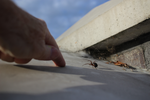
DUGON Michel
Recommendations: 0
Review: 1
Review: 1

The 'Noble false widow' spider Steatoda nobilis is an emerging public health and ecological threat
How the noble false widow spider Steatoda nobilis can turn out to be a rising public health and ecological concern
Recommended by Etienne Bilgo based on reviews by Michel Dugon and 2 anonymous reviewers"The noble false widow spider Steatoda nobilis is an emerging public health and ecological threat" by Clive Hambler (2020) is an appealing article discussing important aspects of the ecology and distribution of a medically significant spider, and the health concerns it raises.
By contrast to previous studies (Dunbar et al., 2018; Warell et al., 1991; Bauer et al., 2019; BBC 2013, 2018), this article, with its extensive media and scientific literature review, shows that S. nobilis (Thorell, 1875) is now an important health concern in Britain. Indeed, the author shows that the population of this spider has significantly increased, at least since 1990, in both southern Britain and Ireland where it has remained greatly under-recorded. In these areas, S. nobilis is now often the dominant spider on and in buildings, in places in which there is a high a risk of bites, some of which are likely to be severe, in humans, with these bites largely under-recorded. According to Clive Hambler "There is thus a possibility of bites being left without adequate rapid treatment and monitoring - with a low but non-trivial risk of necrosis or sepsis".
The author points that one of the reasons for the lack of awareness of the risk is that arachnologists typically have a conflict of interest between the conservation of the species they study and raising concerns about spiders. This may lead them to understate the risk. Clive Hambler therefore calls for a closer, appropriately weighted attention to the frequency and risk of bites, based on all the information available, rather than being "dismissive of the possibilities of bites and impacts simply because many media reports contain major errors or alarmism". He also argues that the British Arachnological Society’s guidance on "false widow spiders" "needs substantive revision, both in terms of the likelihood of bites and the severity of effects."
Indeed, the author demonstrates that many inaccuracies have been published (see Table 3 of his manuscript) and, for each, he provides a correction and/or an alternative opinion. At the end of this MS (see Table 4), he provides testable speculations and hypotheses. As he rightly points out, testing is very important to fuel the debate, because "It will be very difficult to get a balanced and proportionate debate and response for such a confused and emotive issue, especially with the many misleading popular reports." He also suggests that research will require interdisciplinary collaboration between experts in many domains, including pathologists, immunologists, clinicians, ecologists, arachnologists, psychologists, physiologists, climatologists and epidemiologists.
This preprint is clearly descriptive and speculative, but well-written, interesting and certainly useful in terms of a review of the biology, ecology, potential dangerousness and distribution of S. nobilis, particularly for future studies. There is no doubt that arachnologists, the medical community and the media will be interested in this article, which is intended to sound the alarm. Naturalists in general will also be interested in this manuscript because it is an original and successful attempt to increase knowledge about a particular taxon based on diverse information sources.
The structure of the MS is a bit odd, with a certain toing-and-froing between the ecology/biology/distribution of the spider and the risks, dangerousness and venom of bites, but this is not problematic, as shown by the reviews of the manuscript - three reviews (available below) were written, two by specialists in this noble false widow (Michel Dugon and another researcher who wished to remain anonymous).
Despite the controversy surrounding certain of the statements made in this article, I therefore strongly recommend it and look forward to seeing the identified research priorities addressed.
References
[1] Hambler, C. (2020). The “Noble false widow” spider Steatoda nobilis is an emerging public health and ecological threat. OSF Preprints, axbd4, ver. 4 peer-reviewed and recommended by PCI Zoology. doi: 10.31219/osf.io/axbd4
[2] Dunbar J.P., Afoullouss S., Sulpice R., Dugon M.M. (2018) Envenomation by the noble false widow spider Steatoda nobilis (Thorell, 1875) - five new cases of steatodism from Ireland and Great Britain. Clin Toxicol (Phila). 56(6):433-435. doi: 10.1080/15563650.2017.1393084
[3] Warrell D.A., Shaheen J., Hillyard P.D., Jones D. (1991) Neurotoxic envenoming by an immigrant spider (Steatoda nobilis) in southern England. Toxicon. 29(10):1263-5. doi: 10.1016/0041-0101(91)90198-Z
[4] Bauer, T., Feldmeier, S., Krehenwinkel, H., Wieczorrek, C., Reiser, N. and Dreitling, R. (2019) Steatoda nobilis, a false widow on the rise: a synthesis of past and current distribution trends. NeoBiota 42: 19–43. doi: 10.3897/neobiota.42.31582
[5] BBC (2013). False widow spider bites footballer Steve Harris. http://www.bbc.co.uk/news/uk-england-devon-24470023 Accessed 1 November 2018.
[6] BBC (2018). False widow spider infestation schools to remain shut. https://www.bbc.co.uk/news/uk-england-london-45761046 Accessed 19 December 2018.